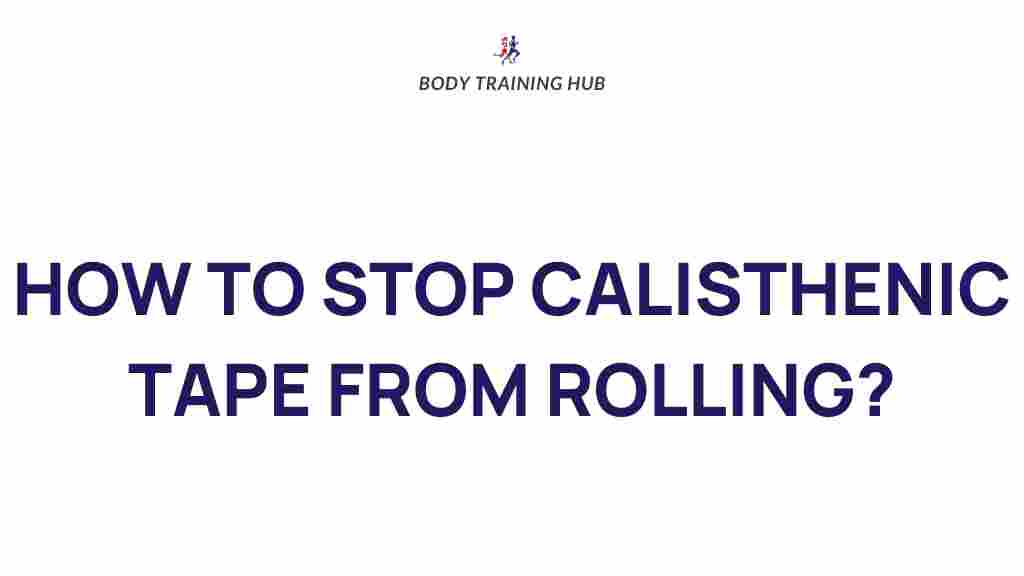Unraveling the Mystery of Calisthenic Tape: Tips to Prevent Rolling
When it comes to workout gear, few items are as essential as calisthenic tape. This fitness accessory has become a staple for athletes looking to enhance their performance while minimizing the risk of injury. However, one common problem that users face is the tape rolling up during workouts. In this article, we will explore the mysteries of calisthenic tape, provide tips to prevent rolling, and offer insights into choosing the right athletic tape for your needs.
What is Calisthenic Tape?
Calisthenic tape, also known as athletic tape, is designed to provide support and stability to muscles and joints during physical activity. It can help prevent injuries, reduce pain, and facilitate recovery. This type of tape is particularly popular among athletes who engage in high-intensity workouts, including calisthenics, weightlifting, and other sports that require agility and strength.
The Importance of Preventing Rolling
One of the biggest frustrations for athletes using calisthenic tape is when it begins to roll during their workouts. This can not only be distracting but can also reduce the tape’s effectiveness in providing support. Preventing rolling is crucial for ensuring that you get the most out of your fitness accessories. Here are some reasons why rolling can be detrimental:
- Reduced Support: When tape rolls, it loses its ability to support muscles and joints, increasing the risk of injury.
- Distraction: A tape that rolls can become a significant distraction during workouts, hindering your focus and performance.
- Wasted Product: If your tape rolls up, you may end up wasting product as you need to reapply it, leading to increased costs.
Tips to Prevent Rolling of Calisthenic Tape
To ensure your calisthenic tape stays in place throughout your workout, follow these steps:
1. Prepare Your Skin
Before applying calisthenic tape, it’s essential to prepare your skin properly:
- Clean the Area: Wash the area where you plan to apply the tape. This helps remove oils and dirt that can prevent adhesion.
- Dry Completely: Ensure the skin is completely dry. Moisture can cause the tape to peel off.
- Shave Hair if Necessary: If you have body hair in the area, consider shaving it to improve adhesion.
2. Apply Tape Correctly
The way you apply your calisthenic tape can greatly affect its performance. Here are some tips:
- Use the Right Tension: Apply the tape with the appropriate tension. Too tight can cause rolling, while too loose won’t provide adequate support.
- Anchor Tape on Clean Surface: Ensure that one end of the tape is anchored on a clean, dry surface, which is less likely to roll.
- Overlap Edges: When applying multiple strips, overlap the edges slightly to create a seamless hold.
3. Choose the Right Type of Tape
The type of athletic tape you choose can also affect how well it stays in place. Consider the following:
- Elastic vs. Rigid: Elastic tape provides flexibility, while rigid tape offers more support. Choose based on your activity level.
- Adhesive Quality: Look for high-quality adhesive tapes designed to withstand sweat and movement.
- Water-Resistant Options: If you sweat a lot, consider water-resistant options to keep the tape in place.
4. Timing and Environment
When and where you apply your calisthenic tape can impact its performance:
- Apply Before Workouts: Apply the tape at least 30 minutes before your workout to allow the adhesive to bond properly.
- Temperature Matters: Avoid applying tape in extremely cold or humid conditions, as this can affect adhesion.
5. Use Tape Products Wisely
In addition to proper application techniques, consider the following tape products:
- Pre-tape Spray: Pre-tape sprays can enhance adhesion and help prevent rolling.
- Underwraps: Using an underwrap can provide a base for the tape to adhere better without irritating the skin.
Troubleshooting: What to Do If Your Tape Rolls
Even with the best preparation, you may still experience issues with rolling tape. Here’s how to troubleshoot:
1. Assess the Application
Evaluate how you applied the tape. If it rolled, consider the following:
- Was the skin clean and dry?
- Did you use enough tension during application?
- Were the edges securely anchored?
2. Reapply If Necessary
If the tape continues to roll, it may be best to remove it and reapply. Ensure you follow the preparation and application steps closely.
3. Experiment with Different Tapes
If you consistently face issues with rolling, consider trying different brands or types of calisthenic tape. Some tapes have better adhesion properties than others.
4. Consult Professionals
If you’re unsure about the application techniques, consider consulting a physical therapist or a sports medicine professional for guidance.
Conclusion
Calisthenic tape is an invaluable tool in the world of fitness accessories, providing support and stability during workouts. By taking the time to prepare your skin, apply the tape correctly, choose the right type of tape, and troubleshoot any issues, you can prevent rolling and enhance your workout experience. Remember, the key to maximizing the benefits of your athletic tape lies in the details. For more tips on fitness gear, check out our comprehensive guide on workout accessories. If you’re looking for high-quality calisthenic tape, consider visiting trusted retailers for the best options available. Happy training!
This article is in the category Training Guides and created by BodyTraining Team
